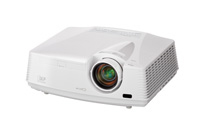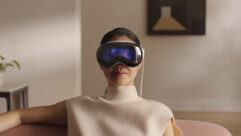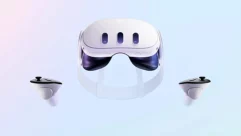

Mitsubishi XD600U Review
Jan 5, 2010 2:37 PM,
By Jeff Sauer
Its brightness per pound and technological advancements make it a user-friendly, forward-thinking projector.
Mitsubishi XD600U
Mitsubishi’s new XD600U projector (along with its 16:9 counterpart XD620U-G) is the top of the company’s line of small form factor, high brightness front projectors aimed squarely at the commercial data presentation core of the market. As a group, these models are small enough to be moved if necessary and easily installed, yet powerful enough to fill a large conference room, boardroom, classroom, or house-of-worship video venue or smaller sanctuary.
Rated at 4500 lumens and weighing 7.9lbs., brightness per pound is the calling card of the new XD600U. Yet the industry has claimed higher brightness many times before and without anymore than its brightness, the XGA-native XD600 would fall into the age-old incremental improvement category. Mitsubishi has, however, endowed the XD600U with a package of other technological advancements that together translate to state-of-the-art user friendliness, as well as a little forward thinking.
The XD600U is DLP-based, with Texas Instruments’ (TI) BrilliantColor technology and a RGBWY five-segment color wheel. That extra Y (yellow) in the color wheel is what yields the added brightness from the 280W lamp while maintaining fairly good color and not washing out lighter hues, particularly skin tones. Of course, high brightness and a traditional XGA resolution make the XD600U a straightforward, utilitarian projector.
Connectivity is straightforward, with two 15-pin VGA inputs and one 15-pin pass-through for a local monitor. Both 15-pins can accept component video with a splitter cable. S-Video and composite jacks share RCA stereo audio jacks, and there are stereo mini jacks for each of the data inputs. An RS-232 and RJ-45 port are for control and Internet connectivity. That’s all simple enough, but there’s more than meets the eye in that inputs list.
First, Mitsubishi now offers an interesting “audio mix” function that allows the projector to mix and output two combined audio inputs. In other words, without an external audio mixer, the XD600U can simultaneously output the audio from video or a computer source and a speaker’s microphone, for example. If the projector is installed overhead in a large conference room, classroom, or sanctuary, the 10W built-in loudspeaker can serve as a very affordable, if somewhat rudimentary audio enhancement system.
Ethernet connectivity and remote projector monitoring isn’t new, but it does afford easier control and operation of ceiling-mounted projectors or a facility with multiple units. Mitsubishi has also added another interesting feature that allows the projector to be used as a public address broadcaster: a simple piece of remote administration software allows a control-room administrator to type messages up to 350 characters and send them to one or many projectors for immediate display. That could be quite handy if a speaker is running 10 minutes behind schedule or a meeting location has changed. Naturally, the projector includes password protection both for network access and on-screen menu access.
Since the XD600U is small enough to be moved from one room to another, Mitsubishi has also included some features to help with quick and easy set-up. The Wall Screen feature isn’t new, but it corrects color if one needs to use less-than-ideal projection surfaces, such as beige walls. Of course, there’s also auto keystone correction. Mitsubishi has both a Quick Menu for basic set-up as well as a Detail Menu that goes into the detail that installers would expect including dedicated RGB color, brightness, and contrast controls; TI’s Color Enhancer technology goes beyond basic viewing mode presets and offers quick preset adjustments for Gamma Mode, BrilliantColor, RGB Color, and RGB Tint settings.
Finally, the XD600U is 3D-ready. What does that mean? It probably does not mean too much unless you’re already working with 3D visualization or need to get there quickly. Indeed, while the Mitsubishi website now touts 3D, the XD600U user manual barely touches on it save for an English-as-a-second-language paper insert that loosely refers to the need for 3D content and LCD shutter glasses. Yet that’s because 3D ready is effectively inherent in the underlying DLP technology (although 3D is not available in the widescreen XD620U-G) and something that TI is now publicizing as a marketing advantage. The DLP approach to 3D is quite good visually, but the 3D industry has yet to standardize, and that makes the emergence of future content a little suspect. Still, for those that are working with 3D visualization, the XD600U is ready.
Mitsubishi XD600U Review
Jan 5, 2010 2:37 PM,
By Jeff Sauer
Its brightness per pound and technological advancements make it a user-friendly, forward-thinking projector.
High Brightness is No Exaggeration
The XD600U’s RGBWY five-segment color wheel was designed to achieve maximum brightness while still maintaining reasonable color accuracy. And Mitsubishi delivers. I measured a little less than 4400 lumens (4397) in Presentation mode. As you would expect, that brightness drops by almost 40 percent in Standard mode to 2738 lumens and down to 1191 in Theater mode.
The trade-off is that with less brightness, and less reliance on the white and yellow color-wheel segments, Standard and Theater modes can offer more accurate color reproduction. Specifically, yellow and cyan secondary colors, which skew heavily toward green in Presentation mode, move back toward where they should be. However, even in Theater mode, cyan stays too far toward green, as do primaries blue and red.
Pleasantly, Mitsubishi hasn’t exaggerated its contrast ratio claims either. I measured 2107:1 in Presentation mode and that was more than the 2000:1 number on the spec sheet. Like brightness, contrast ratios drop in the other modes to 1573:1 in Standard mode and down to 804:1 in Theater mode. The various Color Enhancer settings also have a noticeable affect on brightness and contrast measurement, which will allow installers to find the right balance between brightness and color in particular ambient lighting and room environments.
It’s that flexibility of power when needed and user-friendly features that make the XD600U more than the sum of its otherwise incremental improvements. And of course, through the prism of where the industry was just a few years ago, the XD600U’s improvements are nothing short of phenomenal.
Product Summary
Company: Mitsubishi
www.mitsubishi-presentations.com
Product: XD600U
Pros: High brightness when needed; good contrast; audio mix feature; potential 3D capabilities; networking.
Cons: Trade-off between peak brightness and accurate color.
Application: Large boardrooms, conference rooms, lecture halls, and houses of worship.
Price: $1,895
Specifications
Brightness: 4500 ANSI lumens
Contrast: 2000:1 full on/off
Native resolution: 1024×768 (XGA)
Configuration: 1x 0.7in. DLP DMD, five-segment (RGBWY) color wheel
Light source: 280W lamp (3000 hours, 5000 hours in Low mode)
Lens ratio: Manual focus, 1.4-2.1
Zoom: Manual 1.5:1 optical zoom, F=2.4-2.8, f=20.6-31.0mm
Projection distance: 3.7ft.-43.1ft.
Screen size: 40-300 diagonal inches
Loudspeakers: 10W monoaural
Dimensions: 13.6”x5.1”x 10.6” (WxHxD)
Weight: 7.9lbs.
Warranty: Three year parts and labor









